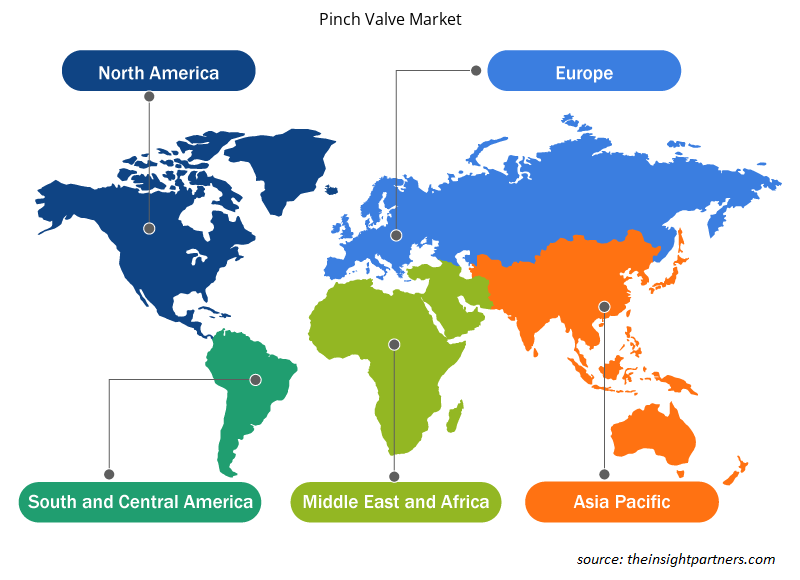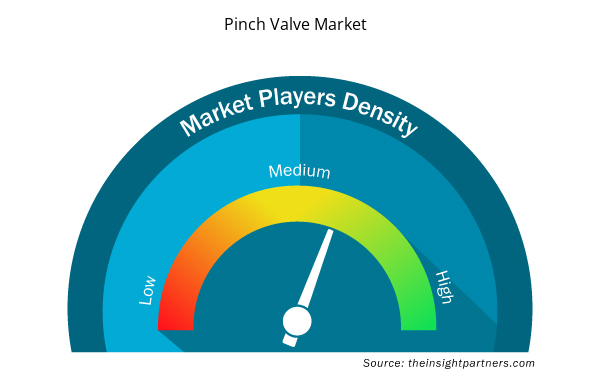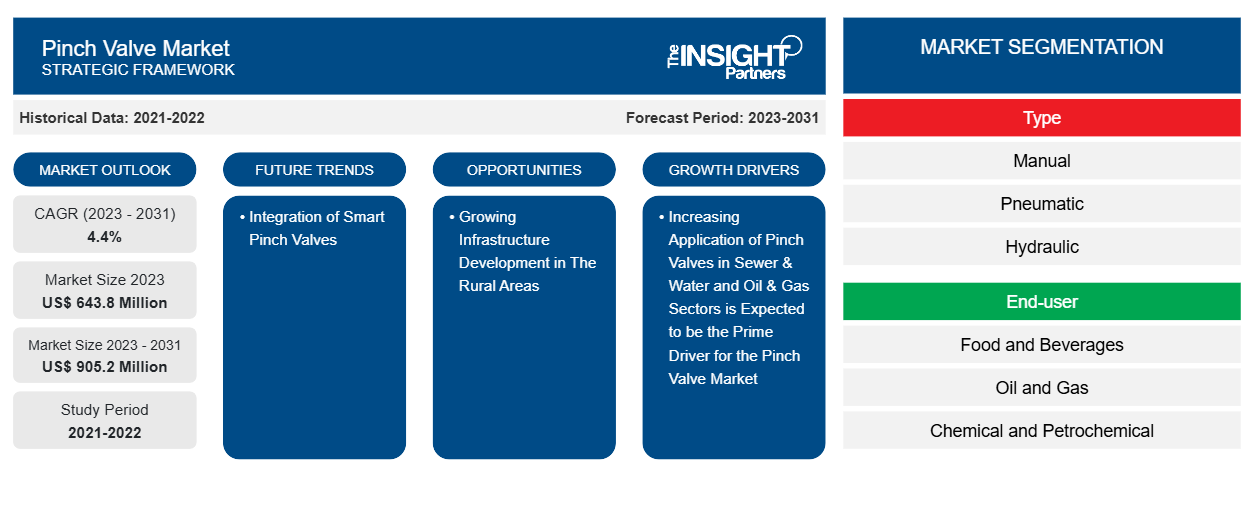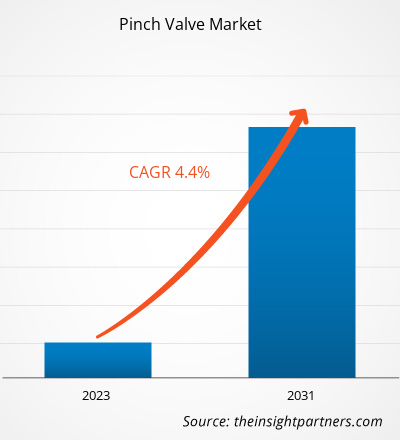Der Markt für Quetschventile soll von 643,8 Millionen US-Dollar im Jahr 2023 auf 905,2 Millionen US-Dollar im Jahr 2031 anwachsen. Der Markt soll zwischen 2023 und 2031 eine durchschnittliche jährliche Wachstumsrate von 4,4 % verzeichnen. Die wachsende Entwicklung der Öl- und Gasindustrie sowie der zunehmende Fokus der Regierung auf die Erhöhung der Zahl von Wasser- und Abwasseraufbereitungsanlagen sind die Haupttreiber für das Wachstum des Quetschventilmarktes weltweit.CAGR of 4.4% during 2023–2031. The growing development of the oil & gas industry, along with rising government focus on increasing the number of water and wastewater treatment facilities, are acting as major drivers for the growth of the pinch valves market globally.
Quetschventil Marktanalyse
Die boomenden Öl- und Gas-, Petrochemie- und Chemiebranchen haben die Nachfrage nach Quetschventilen in die Höhe getrieben, da sie eine wichtige Rolle bei der Steuerung des Flüssigkeitsflusses in industriellen Anlagen spielen. Darüber hinaus fördern die steigende Zahl von Öl- und Gasraffinerien und zunehmende staatliche Initiativen zur Steigerung der Zahl von Wasser- und Abwasseranlagen den Einsatz von Quetschventilen auf globaler Ebene. Das Abwasservolumen steigt aufgrund des Bevölkerungswachstums. Industrie und Haushalte erzeugen den Großteil des Abwassers. Weltweit werden jedes Jahr etwa 380 Milliarden Kubikmeter kommunales Abwasser produziert, was den Bedarf an einer angemessenen Infrastrukturentwicklung im Abwasser- und Wassersektor erhöht. Somit treibt die wachsende Bevölkerung den Markt für Quetschventile an.
Quetschventil Marktübersicht
Der Markt für Quetschventile wird nach Typ, Endverbraucher und Geografie kategorisiert. Basierend auf dem Typ wird der Markt in manuelle, pneumatische, hydraulische und elektrische Ventile segmentiert. Basierend auf dem Endverbraucher wird der Markt in Lebensmittel und Getränke, Öl und Gas, Chemie und Petrochemie, Wasser und Abwasser und andere unterteilt. Die wachsende Zahl von Öl- und Gasanlagen sowie ein zunehmender Fokus auf ordnungsgemäße Abwasser- und Entwässerungsanlagen zur Einhaltung der Hygiene sind ein Schlüsselfaktor, der den Einsatz von Quetschventilen fördert. Die wachsende Bedeutung von Wasser- und Abwasseraufbereitungsanlagen zur Aufrechterhaltung der Umwelthygiene und die zunehmende Entwicklung intelligenter Städte werden voraussichtlich auch das Wachstum des Quetschventilmarktes im Prognosezeitraum vorantreiben.
Passen Sie diesen Bericht Ihren Anforderungen an
Sie erhalten kostenlos individuelle Anpassungen an jedem Bericht, einschließlich Teilen dieses Berichts oder einer Analyse auf Länderebene, eines Excel-Datenpakets sowie tolle Angebote und Rabatte für Start-ups und Universitäten.
- Holen Sie sich die wichtigsten Markttrends aus diesem Bericht.Dieses KOSTENLOSE Beispiel umfasst eine Datenanalyse von Markttrends bis hin zu Schätzungen und Prognosen.
Markttreiber und Chancen für Quetschventile
Zunehmender Einsatz von Quetschventilen in den Bereichen Abwasser und Wasser sowie Öl und Gas
Die Regierungen verschiedener Länder legen Wert auf die Installation angemessener Abwasser- und Abwasseraufbereitungsanlagen, um die Umwelt vor Verschmutzung zu schützen. So hat die Ranchi Municipal Corporation im Jahr 2024 im Rahmen ihres Abwassermanagementsystems in neun Bezirken ein Pipeline-Verlegungsprojekt eingeleitet. Das Projekt umfasst den Anschluss von Haushaltsklärgruben an die Abwasserleitungen. Darüber hinaus unterzeichnete Cambi im Jahr 2023 eine Vereinbarung mit Schwerpunkt auf der Woodman Point Water Resource Recovery Facility in Perth und Westaustralien. Darüber hinaus steigt der Energiebedarf aufgrund der wachsenden Weltbevölkerung stark an. Angesichts der zunehmenden Energieunsicherheiten fördern die Regierungen mehrerer Länder die Nutzung von Erdgas. Infolgedessen nehmen die Öl- und Gasexplorationsaktivitäten weltweit zu. Der zunehmende Fokus der Regierungen auf die Erhöhung der Zahl von Wasser- und Abwasseraufbereitungsanlagen und die zunehmende Entwicklung im Öl- und Gassektor sind daher die Haupttreiber für den Markt für Quetschventile.Ranchi Municipal Corporation initiated a pipeline laying project under its sewage management system across nine wards. The project involves joining household septic tanks to the sewer lines. In addition, in 2023, Cambi signed an agreement focusing on the Woodman Point Water Resource Recovery Facility in Perth and Western Australia. Moreover, there is a surge in energy demand due to the growing global population. With the increasing energy uncertainties, governments of several countries are boosting the application of natural gas. As a result, oil and gas exploration activities are growing across the globe. Thus, rising government focus on increasing the number of water and wastewater treatment facilities and growing development in the oil and
Infrastrukturentwicklung in ländlichen Gebieten
Eine ausreichende Wasserversorgung und angemessene Abwasserentsorgung sind einige der Voraussetzungen für eine moderne Abwasserentsorgungs- und Abwassermanagementinfrastruktur. Die Entwicklung neuer Infrastrukturen wie Universitäten, Schulen, Geschäftsräume und Wohnhäuser in den ländlichen Gebieten eines Landes wird im Prognosezeitraum voraussichtlich große Chancen für den Einsatz von Quetschventilen bieten.
Quetschventil-Marktbericht – Segmentierungsanalyse
Wichtige Segmente, die zur Ableitung der Quetschventil-Marktanalyse beigetragen haben, sind Typ und Endbenutzer.
- Je nach Typ ist der Markt für Quetschventile in manuelle, pneumatische, hydraulische und elektrische unterteilt. Das pneumatische Segment hatte im Jahr 2023 den größten Marktanteil.
- Nach Endverbraucher wurde der Markt in Lebensmittel und Getränke, Öl und Gas, Chemie und Petrochemie, Wasser und Abwasser und andere segmentiert. Das Segment Lebensmittel und Getränke dominierte den Markt im Jahr 2023.
Quetschventil Marktanteilsanalyse nach Geografie
Der geografische Umfang des Marktberichts für Quetschventile ist hauptsächlich in fünf Regionen unterteilt: Nordamerika, Europa, Asien-Pazifik, Naher Osten und Afrika sowie Süd- und Mittelamerika.
Der asiatisch-pazifische Raum dominierte den Quetschventilmarkt im Jahr 2023. Der Markt für Quetschventile im asiatisch-pazifischen Raum ist in China, Australien, Indien, Japan und Südkorea unterteilt. Die rasante Entwicklung von Technologien wie intelligenten Quetschventilen in den Bereichen Lebensmittel und Getränke, Chemie sowie Wasser- und Abwassermanagement ist der Haupttreiber für den Quetschventilmarkt. Die wachsende Bevölkerung und die Urbanisierung treiben auch den Quetschventilmarkt im asiatisch-pazifischen Raum an.
Regionale Einblicke in den Quetschventilmarkt
Die regionalen Trends und Faktoren, die den Quetschventilmarkt während des Prognosezeitraums beeinflussen, wurden von den Analysten von Insight Partners ausführlich erläutert. In diesem Abschnitt werden auch Quetschventilmarktsegmente und die Geografie in Nordamerika, Europa, im asiatisch-pazifischen Raum, im Nahen Osten und Afrika sowie in Süd- und Mittelamerika erörtert.

- Erhalten Sie regionale Daten zum Quetschventilmarkt
Umfang des Quetschventil-Marktberichts
| Berichtsattribut | Details |
|---|---|
| Marktgröße im Jahr 2023 | 643,8 Millionen US-Dollar |
| Marktgröße bis 2031 | 905,2 Millionen US-Dollar |
| Globale CAGR (2023 - 2031) | 4,4 % |
| Historische Daten | 2021-2022 |
| Prognosezeitraum | 2023–2031 |
| Abgedeckte Segmente | Nach Typ
|
| Abgedeckte Regionen und Länder | Nordamerika
|
| Marktführer und wichtige Unternehmensprofile |
|
Marktteilnehmerdichte für Quetschventile: Auswirkungen auf die Geschäftsdynamik verstehen
Der Markt für Quetschventile wächst rasant, angetrieben durch die steigende Nachfrage der Endverbraucher aufgrund von Faktoren wie sich entwickelnden Verbraucherpräferenzen, technologischen Fortschritten und einem größeren Bewusstsein für die Vorteile des Produkts. Mit steigender Nachfrage erweitern Unternehmen ihr Angebot, entwickeln Innovationen, um die Bedürfnisse der Verbraucher zu erfüllen, und nutzen neue Trends, was das Marktwachstum weiter ankurbelt.
Die Marktteilnehmerdichte bezieht sich auf die Verteilung der Firmen oder Unternehmen, die in einem bestimmten Markt oder einer bestimmten Branche tätig sind. Sie gibt an, wie viele Wettbewerber (Marktteilnehmer) in einem bestimmten Marktraum im Verhältnis zu seiner Größe oder seinem gesamten Marktwert präsent sind.
Die wichtigsten auf dem Quetschventilmarkt tätigen Unternehmen sind:
- AKO Armaturen & Separationstechnik GmbH
- Cla-Va
- Emerson Electric Co.
- Flowrox Oy
- Red Valve Company, Inc
Haftungsausschluss : Die oben aufgeführten Unternehmen sind nicht in einer bestimmten Reihenfolge aufgeführt.

- Überblick über die wichtigsten Akteure auf dem Quetschventilmarkt
Neuigkeiten und aktuelle Entwicklungen zum Quetschventilmarkt
Der Markt für Quetschventile wird durch die Erhebung qualitativer und quantitativer Daten nach Primär- und Sekundärforschung bewertet, die wichtige Unternehmensveröffentlichungen, Verbandsdaten und Datenbanken umfasst. Nachfolgend sind einige Entwicklungen auf dem Markt für Quetschventile aufgeführt:
- Emerson stellte seine Fisher Whisper Trim-Technologie für den Einsatz in Ventilen vor. (Quelle: Emerson, Pressemitteilung/Unternehmenswebsite/Newsletter, November 2023)
- Emerson hat seinen Fisher FIELDVUE L2t Flüssigkeitsstandregler auf den Markt gebracht, der in erster Linie für den Einsatz in Öl- und Gasbohrstellen entwickelt wurde. (Quelle: Emerson, Pressemitteilung/Unternehmenswebsite/Newsletter, Dezember 2023)
Marktbericht zu Quetschventilen – Umfang und Ergebnisse
Der Bericht „Marktgröße und Prognose für Quetschventile (2021–2031)“ bietet eine detaillierte Analyse des Marktes, die die folgenden Bereiche abdeckt:
- Quetschventil-Marktgröße und -prognose auf globaler, regionaler und Länderebene für alle wichtigen Marktsegmente, die im Rahmen des Berichts abgedeckt sind
- Markttrends für Quetschventile sowie Marktdynamiken wie Treiber, Einschränkungen und wichtige Chancen
- Detaillierte PEST/Porters Five Forces- und SWOT-Analyse
- Marktanalyse für Quetschventile mit Blick auf wichtige Markttrends, globale und regionale Rahmenbedingungen, wichtige Akteure, Vorschriften und aktuelle Marktentwicklungen
- Branchenlandschaft und Wettbewerbsanalyse, einschließlich Marktkonzentration, Heatmap-Analyse, prominenten Akteuren und aktuellen Entwicklungen auf dem Quetschventilmarkt
- Detaillierte Firmenprofile
- Historische Analyse (2 Jahre), Basisjahr, Prognose (7 Jahre) mit CAGR
- PEST- und SWOT-Analyse
- Marktgröße Wert/Volumen – Global, Regional, Land
- Branche und Wettbewerbsumfeld
- Excel-Datensatz


- E-Bike Market
- Extracellular Matrix Market
- Adaptive Traffic Control System Market
- Analog-to-Digital Converter Market
- Fish Protein Hydrolysate Market
- Single-Use Negative Pressure Wound Therapy Devices Market
- Embolization Devices Market
- Identity Verification Market
- Non-Emergency Medical Transportation Market
- Long Read Sequencing Market

Report Coverage
Revenue forecast, Company Analysis, Industry landscape, Growth factors, and Trends

Segment Covered
This text is related
to segments covered.

Regional Scope
North America, Europe, Asia Pacific, Middle East & Africa, South & Central America

Country Scope
This text is related
to country scope.
Häufig gestellte Fragen
The pinch valve market is expected to register a CAGR of 4.4% during 2023–2031
The pinch valve market size is projected to reach US$ 905.2 million by 2031
Governments of various countries are emphasizing installing proper wastewater and sewage treatment facilities to protect the environment from pollution. Rising infrastructure development is anticipated to remain a key driver for pinch valve market growth.
Asia Pacific dominated the pinch valve market in 2023.
Trends and growth analysis reports related to Manufacturing and Construction : READ MORE..
The Insight Partners performs research in 4 major stages: Data Collection & Secondary Research, Primary Research, Data Analysis and Data Triangulation & Final Review.
- Data Collection and Secondary Research:
As a market research and consulting firm operating from a decade, we have published and advised several client across the globe. First step for any study will start with an assessment of currently available data and insights from existing reports. Further, historical and current market information is collected from Investor Presentations, Annual Reports, SEC Filings, etc., and other information related to company’s performance and market positioning are gathered from Paid Databases (Factiva, Hoovers, and Reuters) and various other publications available in public domain.
Several associations trade associates, technical forums, institutes, societies and organization are accessed to gain technical as well as market related insights through their publications such as research papers, blogs and press releases related to the studies are referred to get cues about the market. Further, white papers, journals, magazines, and other news articles published in last 3 years are scrutinized and analyzed to understand the current market trends.
- Primary Research:
The primarily interview analysis comprise of data obtained from industry participants interview and answers to survey questions gathered by in-house primary team.
For primary research, interviews are conducted with industry experts/CEOs/Marketing Managers/VPs/Subject Matter Experts from both demand and supply side to get a 360-degree view of the market. The primary team conducts several interviews based on the complexity of the markets to understand the various market trends and dynamics which makes research more credible and precise.
A typical research interview fulfils the following functions:
- Provides first-hand information on the market size, market trends, growth trends, competitive landscape, and outlook
- Validates and strengthens in-house secondary research findings
- Develops the analysis team’s expertise and market understanding
Primary research involves email interactions and telephone interviews for each market, category, segment, and sub-segment across geographies. The participants who typically take part in such a process include, but are not limited to:
- Industry participants: VPs, business development managers, market intelligence managers and national sales managers
- Outside experts: Valuation experts, research analysts and key opinion leaders specializing in the electronics and semiconductor industry.
Below is the breakup of our primary respondents by company, designation, and region:

Once we receive the confirmation from primary research sources or primary respondents, we finalize the base year market estimation and forecast the data as per the macroeconomic and microeconomic factors assessed during data collection.
- Data Analysis:
Once data is validated through both secondary as well as primary respondents, we finalize the market estimations by hypothesis formulation and factor analysis at regional and country level.
- Macro-Economic Factor Analysis:
We analyse macroeconomic indicators such the gross domestic product (GDP), increase in the demand for goods and services across industries, technological advancement, regional economic growth, governmental policies, the influence of COVID-19, PEST analysis, and other aspects. This analysis aids in setting benchmarks for various nations/regions and approximating market splits. Additionally, the general trend of the aforementioned components aid in determining the market's development possibilities.
- Country Level Data:
Various factors that are especially aligned to the country are taken into account to determine the market size for a certain area and country, including the presence of vendors, such as headquarters and offices, the country's GDP, demand patterns, and industry growth. To comprehend the market dynamics for the nation, a number of growth variables, inhibitors, application areas, and current market trends are researched. The aforementioned elements aid in determining the country's overall market's growth potential.
- Company Profile:
The “Table of Contents” is formulated by listing and analyzing more than 25 - 30 companies operating in the market ecosystem across geographies. However, we profile only 10 companies as a standard practice in our syndicate reports. These 10 companies comprise leading, emerging, and regional players. Nonetheless, our analysis is not restricted to the 10 listed companies, we also analyze other companies present in the market to develop a holistic view and understand the prevailing trends. The “Company Profiles” section in the report covers key facts, business description, products & services, financial information, SWOT analysis, and key developments. The financial information presented is extracted from the annual reports and official documents of the publicly listed companies. Upon collecting the information for the sections of respective companies, we verify them via various primary sources and then compile the data in respective company profiles. The company level information helps us in deriving the base number as well as in forecasting the market size.
- Developing Base Number:
Aggregation of sales statistics (2020-2022) and macro-economic factor, and other secondary and primary research insights are utilized to arrive at base number and related market shares for 2022. The data gaps are identified in this step and relevant market data is analyzed, collected from paid primary interviews or databases. On finalizing the base year market size, forecasts are developed on the basis of macro-economic, industry and market growth factors and company level analysis.
- Data Triangulation and Final Review:
The market findings and base year market size calculations are validated from supply as well as demand side. Demand side validations are based on macro-economic factor analysis and benchmarks for respective regions and countries. In case of supply side validations, revenues of major companies are estimated (in case not available) based on industry benchmark, approximate number of employees, product portfolio, and primary interviews revenues are gathered. Further revenue from target product/service segment is assessed to avoid overshooting of market statistics. In case of heavy deviations between supply and demand side values, all thes steps are repeated to achieve synchronization.
We follow an iterative model, wherein we share our research findings with Subject Matter Experts (SME’s) and Key Opinion Leaders (KOLs) until consensus view of the market is not formulated – this model negates any drastic deviation in the opinions of experts. Only validated and universally acceptable research findings are quoted in our reports.
We have important check points that we use to validate our research findings – which we call – data triangulation, where we validate the information, we generate from secondary sources with primary interviews and then we re-validate with our internal data bases and Subject matter experts. This comprehensive model enables us to deliver high quality, reliable data in shortest possible time.


 Holen Sie sich ein kostenloses Muster für diesen Bericht
Holen Sie sich ein kostenloses Muster für diesen Bericht